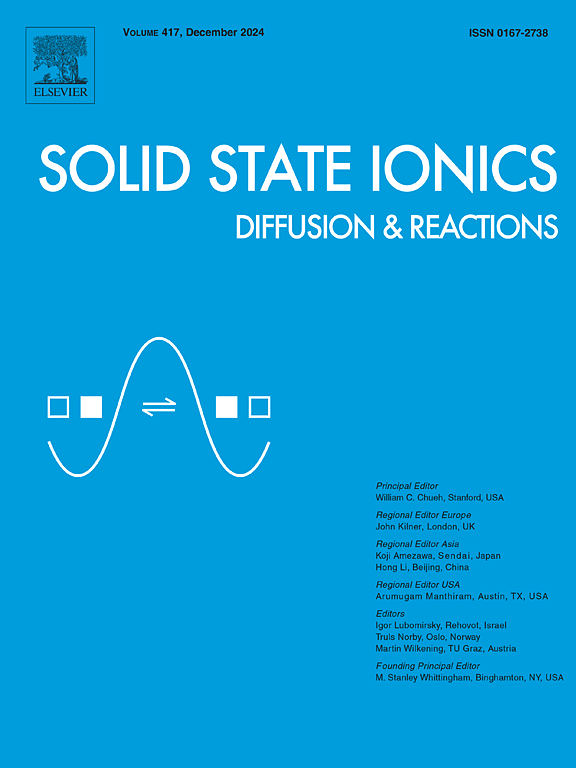Current-overpotential relationships from electrochemical impedance spectroscopy (EIS) under DC bias – A tutorial exercise applied to a Pt||YSZ electrode
IF 3.3
4区 材料科学
Q3 CHEMISTRY, PHYSICAL
引用次数: 0
Abstract
Electrochemical impedance spectroscopy (EIS) of electrode polarisation offers the possibility to delineate overpotentials into ohmic, charge transfer kinetic, and transport and other mass transfer contributions, commonly applied and interpreted under open circuit conditions. It is sometimes also applied under DC bias, as it in principle then can provide information about net anodic or cathodic processes. However, the impedances so obtained are seldomly converted to overpotentials and therefore remain as qualitative indicators only. Here, we tutorially derive formalism of converting resistances from EIS under DC bias properly into overpotential contributions to the total overpotential, allowing identification of their origins from their dependencies on the current. We illustrate the methodology by generated model current-voltage curves and then apply it to an experimental data set for a Pt electrode on an yttria-stabilised zirconia (YSZ) oxide ion conducting electrolyte. The result reveals that a dominating electrode polarisation easily taken to reflect mass transfer in fact behaves like a second charge transfer step following Butler-Volmer kinetics, allowing us to hypothesise a new model for the O2,Pt||YSZ electrode. Our tutorial exercise is applicable to both liquid- and solid-state electrochemistry and should apply equally also to EIS under DC bias of any types of junctions.
直流偏压下电化学阻抗谱(EIS)的电流-过电位关系-应用于Pt||YSZ电极的教程练习
电极极化的电化学阻抗谱(EIS)提供了将过电位划分为欧姆、电荷转移动力学、输运和其他传质贡献的可能性,通常在开路条件下应用和解释。它有时也适用于直流偏置,因为它原则上可以提供有关净阳极或阴极过程的信息。然而,这样获得的阻抗很少转化为过电位,因此仅作为定性指标。在这里,我们从教程中推导出将直流偏置下的EIS电阻正确转换为总过电位的过电位贡献的形式,允许从它们对电流的依赖中识别它们的来源。我们通过生成的模型电流-电压曲线来说明该方法,然后将其应用于铂电极在氧化钇稳定氧化锆(YSZ)离子导电电解质上的实验数据集。结果表明,易于反映传质的主导电极极化实际上表现为继Butler-Volmer动力学之后的第二个电荷转移步骤,这使我们能够假设O2,Pt||YSZ电极的新模型。我们的教程练习既适用于液态电化学,也适用于固态电化学,同样也适用于任何类型结的直流偏置下的EIS。
本文章由计算机程序翻译,如有差异,请以英文原文为准。
求助全文
约1分钟内获得全文
求助全文
来源期刊

Solid State Ionics
物理-物理:凝聚态物理
CiteScore
6.10
自引率
3.10%
发文量
152
审稿时长
58 days
期刊介绍:
This interdisciplinary journal is devoted to the physics, chemistry and materials science of diffusion, mass transport, and reactivity of solids. The major part of each issue is devoted to articles on:
(i) physics and chemistry of defects in solids;
(ii) reactions in and on solids, e.g. intercalation, corrosion, oxidation, sintering;
(iii) ion transport measurements, mechanisms and theory;
(iv) solid state electrochemistry;
(v) ionically-electronically mixed conducting solids.
Related technological applications are also included, provided their characteristics are interpreted in terms of the basic solid state properties.
Review papers and relevant symposium proceedings are welcome.
 求助内容:
求助内容: 应助结果提醒方式:
应助结果提醒方式:


